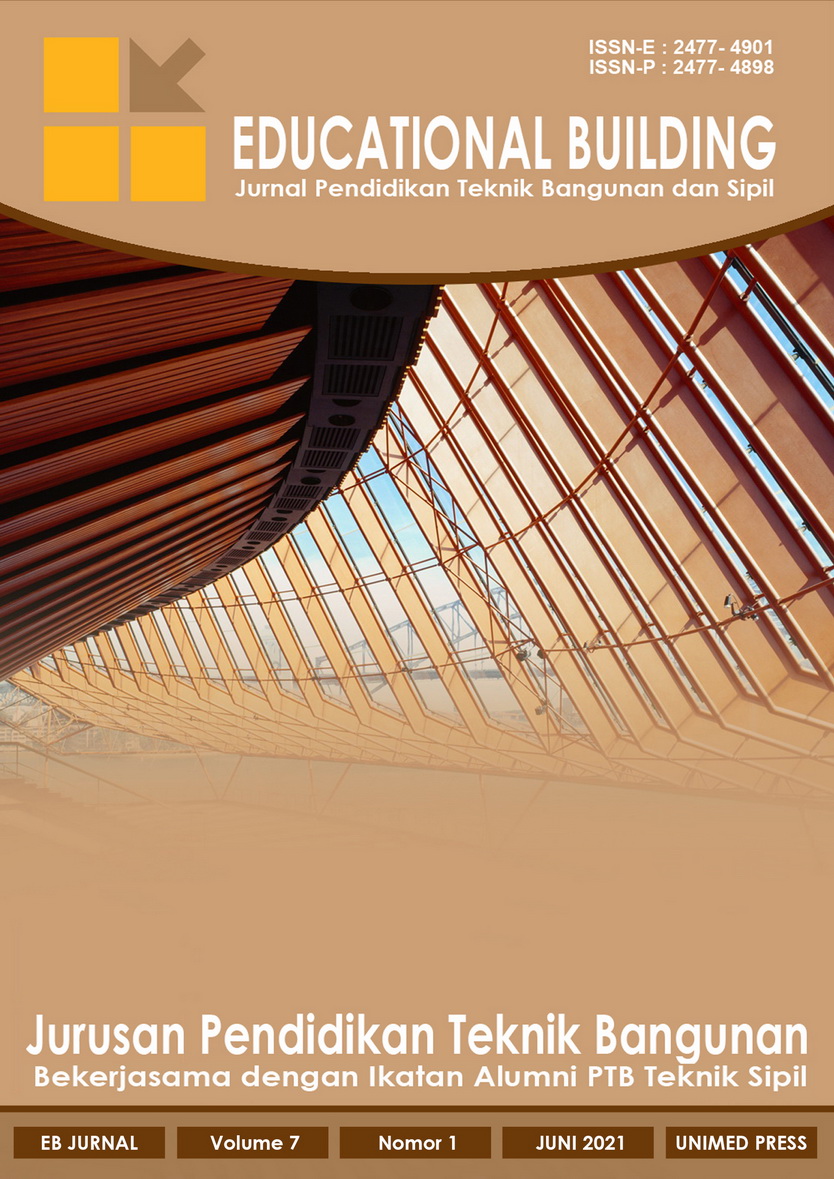PENGARUH JUMLAH PASTA TERHADAP KUAT TEKAN BETON GEOPOLIMER
DOI:
https://doi.org/10.24114/ebjptbs.v7i1%20JUN.26970Abstract
Beton adalah material bangunan yang sering digunakan dalam pekerjaan sipil. Beton terbentuk dari ikatan antara pasta dengan agregat yang setelah mengering akan menghasilkan suatu massa yang padat. Pasta yang terdiri dari campuran air dengan semen mempunyai pengaruh terhadap kuat tekan beton. Pada perancangan beton semen, nilai rasio air-semen yang kecil akan menghasilkan nilai kuat tekan yang tinggi. Jumlah pasta pada beton, akan di pengaruhi seberapa besar rasio air-semen nya, semakin kecil rasio air-semen akan meningkatkan jumlah pasta yang secara tidak langsung akan meningkatkan pula nilai kuat tekan pada beton. Pada beton geopolimer, pasta geopolimer terdiri campuran material alumina-silikat dengan larutan alkali yang fungsi nya sama dengan pasta pada beton semen. Apabila dilihat dari fungsi pasta geopolimer hampir sama dengan pasta pada beton semen, dapat diperkirakan bahwa pasta geopolimer dapat meningkatkan kuat tekan pada beton. Tujuan pada penelitian ini yaitu untuk mengetahui seberapa besar pengaruh jumlah pasta geopolimer terhadap kuat tekan beton geopolimer, dengan NaOH molaritas 6 dan dirawat pada oven selama 24 jam dengan suhu 60-70 °C. Variasi jumlah pasta yang akan diteliti dari 500 “ 700 kg/m3 dengan kelipatan 50 kg/m3. Kuat tekan terkecil sebesar 23,90 MPa pada pasta 500 kg/m3 dan kuat tekan terbesar 47,50 MPa pada pasta 700 kg/m3. Dari hasil kuat tekan yang didapatkan, semakin banyaknya pasta pada beton geopolimer akan meningkatkan pula nilai kuat tekan beton. Setiap penambahan jumlah pasta sebesar 50 kg/m3, dapat meningkatkan kuat tekan beton 10 “ 30 %. Kata Kunci : Beton Geopolimer, Kuat Tekan, dan Pasta Geopolimer, ABSTRACT Concrete is a building material that is often used in civil works. Concrete is formed from the bond between the paste and the aggregate which after drying will produce solid mass. Pastes consisting mixture of water and cement have an effect on the compressive strength of concrete. In the design of cement concrete, a small value of the water-cement ratio will result in a high compressive strength value. The amount of paste in concrete, will be influenced by how much the water-cement ratio is, the smaller the water-cement ratio will increase the amount of paste which will indirectly increase the compressive strength of the concrete. In geopolymer concrete, geopolymer paste consists of a mixture of alumina-silicate material with an alkaline solution whose function is the same as paste in cement concrete. When viewed from the function of geopolymer paste, which is almost the same as paste in cement concrete, it can be estimated that geopolymer paste can increase the compressive strength of concrete. The purpose of this study was to determine how much influence the amount of geopolymer paste had on the compressive strength of geopolymer concrete, with 6 molarity NaOH and treated in an oven for 24 hours at a temperature of 60-70 °C. The variation in the amount of pasta to be studied is from 500“700 kg/m3 with multiples of 50 kg/m3. The smallest compressive strength is 23.90 MPa at 500 kg/m3 paste and the largest compressive strength is 47.50 MPa at 700 kg/m3 paste. From the results of the compressive strength obtained, the more paste on the geopolymer concrete will also increase the value of the compressive strength of the concrete. Each addition of 50 kg/m3 of paste can increase the compressive strength of concrete by 10-30%. Keywords: Geopolymer Paste, Geopolymer Concrete, Compressive StrengthReferences
Davidovits, J. (2008). Geopolymer Chemistry & Applications. Institut Geopolymere. www.geopolymer.org
Hardjasaputra, H., Cornelia, M., Gunawan, Y., Surjaputra, I. V., Lie, H. A., Rachmansyah, & Pranata Ng, G. (2019). Study of mechanical properties of fly ash-based geopolymer concrete. IOP Conference Series: Materials Science and Engineering, 615(1). https://doi.org/10.1088/1757-899X/615/1/012009
Hardjito, D., & Rangan, B. (2005). Development and properties of low-calcium fly ash-based geopolymer concrete. In Research report GC 1. https://doi.org/10.1186/s12893-015-0014-4
Rajamane, N. P., Jeyalaskhmi, N., & Nataraja, M. C. (2014). Quantities of Sodium Hydroxide Solids and Water to Prepare Sodium Hydroxide Solution of Given Molarity for Geopolymer Concrete Mixes. ICI Technical Paper.
SNI 1974:2011. (2011). Cara Uji Kuat Tekan Beton dengan Benda Uji Silinder. Badan Standardisasi Nasional Indonesia.
SNI 7656:2012. (2012). Tata Cara Pemilihan Campuran untuk Beton Normal, Beton Berat dan Beton Massa. Badan Standardisasi Nasional Indonesia.

